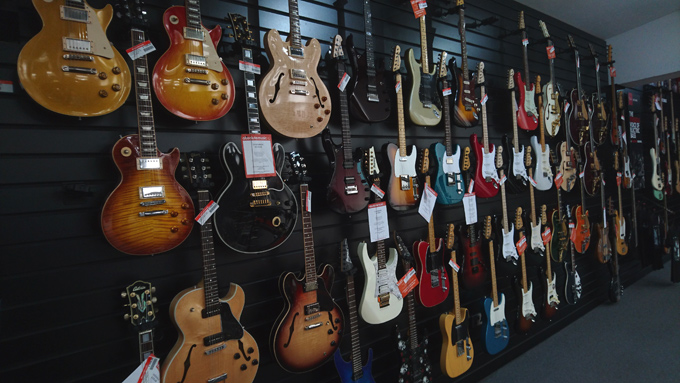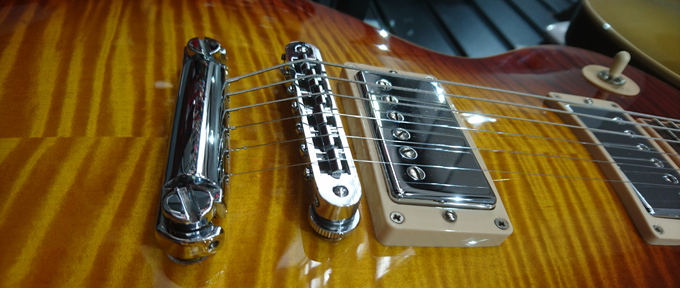Choosing an Electric Guitar
Posted on Wed 05 April 2017 in entries

Our guitar manager Terry Haselden talks us through what you need to consider when buying an electric guitar...
Whether you’re buying your first guitar or adding to an ever-growing collection of beautiful pre-owned models, the guitar world can be a minefield. Where do you begin, with a mass of body shapes, pickup styles and wood types to choose from? This quick guide should throw some light on the choices available to you and help to unite you with your ideal instrument!
GET IT IN THE NECK
Electric guitars fall into two types of construction and it’s all down the neck: bolt-on or fixed (also known as a set or glued neck). What does it all mean though? Well, a guitar’s neck needs to be connected to its body somehow and it can be done in one of two ways.
The method favoured by companies such as Fender, Ibanez, Music Man and Rickenbacker (to name a few of the big boys!) is to bolt the neck to the body. The other technique, the fixed neck method, allows the neck to be glued into the body of the guitar with a wood joint, similar to a ‘dovetail joint’, as used in furniture-making. This method is favoured by companies such as Gibson, Gretsch and PRS Guitars.
So, you’re asking yourself, what are the advantages of each neck? To a large extent the type of neck has an effect on the guitar’s tone and sustain, with fixed neck guitars generally producing a warmer tone with longer sustain. If you’re after a cleaner tone with less sustain, the bolt-on neck is better, but many players love playing both. It’s all a matter of taste!
PICK IT UP NOW
Pickups are the next consideration and it’s not about quantity; more pickups don’t necessarily make a better guitar. In fact some very well known models such as the Fender Esquire or the Gibson and Epiphone Les Paul Junior only have one pickup.
But why only one? Well, it’s down to the tone and what sounds you want your electric guitar to produce. That’s why most pro players have more than one guitar, owning several that are different in construction and pickup type.

The Humbuckers on a Gibson Les Paul
PICKING A PICKUP TYPE
There are also different types of pickup – humbucker or single-coil – and there’s a big difference in tone and volume between each. Humbucker pickups produce a fatter, warmer, louder sound whereas single-coil pickups have a harder, brighter, crisper sound with a bit less volume.
If you listen to a particular style of music you will usually find that there is a pickup type that is associated with that style. If you listen to a Jazz guitarist playing, the pickup is most likely to be a humbucker, giving that unmistakable rich, fat, warm tone. In Country and Western music, single-coil pickups will give the player that typical crisp, clear picking tone. So you’d be unlikely to see Hank Marvin of the Shadows playing a Gibson Les Paul or PRS (humbucker) and equally unlikely to see George Benson playing a Fender Telecaster (single-coil).

The Single Coil Pickups and Trem Unit on a Fender Stratocaster
Think long and hard about what kind of tone you’re looking for and what style of music you’ll be playing when you choose a pickup style. No matter how much you love the look of that beautiful humbuckered Gibson, it’ll never give you that tight, hard sound you need for your death metal!
SHE'S GOT THE BODY
There are plenty of guitar body shapes and styles to choose from and this is a very personal choice. Generally speaking, guitarists are usually drawn to a particular style of guitar based on the guitarists who inspire them and the guitars that they play.
The most popular and most classic choices are a Fender Stratocaster or Telecaster and a Gibson Les Paul or SG. However, with these and the hundreds of other styles out there, the main consideration is how comfortable it will be to play, standing or sitting down. Anyone who’s ever tried to play a Gibson Flying V for more than 15 minutes will know where I’m coming from!
When you try a guitar in our showroom, we’ll always offer you a strap so you can try the guitar standing up as well as sitting down. Just remember to make sure it’s comfortable in both positions, as most of us like to practise or jam at home while sitting down.
Of course, you shouldn’t just jump for the lightest guitar there is, as unsurprisingly, body shape and build can influence the sound. Generally speaking, the heavier the guitar, the more sustain you should get from it. Compare a Gibson Les Paul with a Gibson SG and those extra couple of pounds in body weight in the Les Paul will increase the sustain a bit more. Although the weight may be uncomfortable to start with, if it really is your dream guitar, you (and your muscles) will soon get used to it!
WHICH WOOD'S GOOD?
Zebrawood, bubinga, maple, mahogany… guitars can be made from many types of wood, but I personally feel that it’s not as important in an electric guitar as it is with an acoustic guitar. Most people purchase an electric guitar to play through an amp and once you do this, it’s the pickups that give the guitar its tone rather than the body wood.
Now, I hear you say, if that’s the case, why do some manufacturers use different woods for some models? Well, unless you have very well tuned ears and are playing at high amp volumes, being able to hear the difference between, say, an ash-bodied Strat and an alder wood one is very, very hard. However, if you took the ash guitar and changed the pickups on it, you would hear a difference straight away, as there’s a slight difference in the resonance of the wood body that affects how the pickups capture the strings’ sound (vibration) and output that to the amplifier.
TOP IT OFF WITH A TREM
To trem or not to trem, that is the question! Tremolos are very much down to personal taste and the music that you play. The main thing to remember is that for a tremolo to work properly, it needs to be set up professionally (just as we do day in, day out in our guitar workshop), whether you buy a brand new guitar or a second-hand one.

A Floyd Rose Trem on a Jackson Guitar
The three main tremolo styles are Fender, Floyd Rose and Bigsby. The Bigsby doesn’t do a great deal – it only moves the strings a tiny amount – and while it would be no good at all to Steve Vai or Joe Satriani, in rockabilly style music (à la Brian Setzer), it works very well. There are, of course, various other variations such as a the type found on Fender Jaguar and Jazzmaster guitars that have their roots in the Stratocaster tremolo system.

The Bigsby Trem System on a Gretsch Guitar
The style found on most Fender Stratocasters has been in existence for over 50 years now and is accepted by most players as being a simple but effective accessory… nothing too extreme, and it gets a good workout in the music of Jeff Beck and Hank Marvin. A guitar without a trem system is often referred to as being a 'hardtail'.
If you demand more from your trem then consider a Floyd Rose-style, also known as a locking trem unit because the strings at the nut end of your guitar are locked so the string cannot go out of tune. The downside is that this unit requires constant attention and to change a set of strings will take perhaps 15 minutes longer than on a guitar with a Fender or Bigsby trem.
TAKE YOUR TIME
This has been a brief insight into buying an electric guitar but the main thing to remember is to always ask questions. Don’t be swayed by what your mate/missus/mum thinks. Have a play (sitting and standing), compare it to other models and if in doubt, sleep on it and then come back with a clear head. We’re always happy to let you try out any of our hundreds of guitars in the Absolute Music showroom, so why not pop on down!
Click here to view our range of guitars and accessories online.